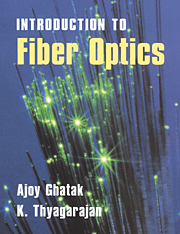Book contents
- Frontmatter
- Contents
- Preface
- Acknowledgments
- Abbreviations
- 1 Introduction: The fiber optics revolution
- 2 Basic optics
- 3 Basic characteristics of the optical fiber
- 4 Ray paths and pulse dispersion in planar optical waveguides
- 5 Pulse dispersion in graded index optical fibers
- 6 Material dispersion
- 7 Modes in planar waveguides
- 8 Propagation characteristics of a step index fiber
- 9 Propagation characteristics of graded index fibers
- 10 Waveguide dispersion and design considerations
- 11 Sources for optical fiber communication
- 12 Detectors for optical fiber communication
- 13 Design considerations of a fiber optic communication system
- 14 Optical fiber amplifiers
- 15 Dispersion compensation and chirping phenomenon
- 16 Optical solitons
- 17 Single-mode fiber optic components
- 18 Single-mode optical fiber sensors
- 19 Measurement methods in optical fibers: I
- 20 Measurement methods in optical fibers: II
- 21 Periodic interactions in waveguides
- 22 The ray equation in cartesian coordinates and its solutions
- 23 Ray paths and their classification in optical fibers
- 24 Leaky modes
- Appendix A Solution of the scalar wave equation for an infinite square law medium
- Appendix B The far-field pattern
- Appendix C WKB analysis of multimode fibers
- Appendix D Gaussian envelope approximation
- Appendix E Coupled-mode equations
- Appendix F Derivation of coupled-mode equation for periodic coupling
- Appendix G Leakage loss in optical waveguides
- References
- Index
18 - Single-mode optical fiber sensors
Published online by Cambridge University Press: 05 June 2012
- Frontmatter
- Contents
- Preface
- Acknowledgments
- Abbreviations
- 1 Introduction: The fiber optics revolution
- 2 Basic optics
- 3 Basic characteristics of the optical fiber
- 4 Ray paths and pulse dispersion in planar optical waveguides
- 5 Pulse dispersion in graded index optical fibers
- 6 Material dispersion
- 7 Modes in planar waveguides
- 8 Propagation characteristics of a step index fiber
- 9 Propagation characteristics of graded index fibers
- 10 Waveguide dispersion and design considerations
- 11 Sources for optical fiber communication
- 12 Detectors for optical fiber communication
- 13 Design considerations of a fiber optic communication system
- 14 Optical fiber amplifiers
- 15 Dispersion compensation and chirping phenomenon
- 16 Optical solitons
- 17 Single-mode fiber optic components
- 18 Single-mode optical fiber sensors
- 19 Measurement methods in optical fibers: I
- 20 Measurement methods in optical fibers: II
- 21 Periodic interactions in waveguides
- 22 The ray equation in cartesian coordinates and its solutions
- 23 Ray paths and their classification in optical fibers
- 24 Leaky modes
- Appendix A Solution of the scalar wave equation for an infinite square law medium
- Appendix B The far-field pattern
- Appendix C WKB analysis of multimode fibers
- Appendix D Gaussian envelope approximation
- Appendix E Coupled-mode equations
- Appendix F Derivation of coupled-mode equation for periodic coupling
- Appendix G Leakage loss in optical waveguides
- References
- Index
Summary
Introduction
Although the major application of optical fibers has been in telecommunications, there is a growing application of optical fibers in sensing applications for measurement of various physical and chemical variables, including pressure, temperature, magnetic field, current, rotation, acceleration, displacement, chemical concentration, pH, and so forth. Such fiber optic sensors are finding applications in industrial process control, the electrical power industry, automobiles, and the defense sector.
One of the main advantages of a fiber optic sensor stems from the fact that optical fibers are purely dielectric and thus can be easily used in hazardous areas where conventional electrically powered sensors would not be safe. In addition, fiber optic sensors are immune to electromagnetic interference, have greater geometric versatility (i.e., they can be configured into a variety of arrangements to suit the application), and should have a very short response time. They can be multiplexed into various configurations and the information from various sensors can be transmitted over long distances by optical fibers. They can also be configured to provide spatially distributed measurements of external parameters.
In a typical optical fiber sensor, light from a source such as a laser diode or LED is guided by an optical fiber to the sensing region. Some property of the propagating light beam gets modulated by the external measurand such as pressure, temperature, magnetic field, and so forth. The modulated light beam is then sent via another (or the same) optical fiber for detection and processing.
- Type
- Chapter
- Information
- An Introduction to Fiber Optics , pp. 397 - 410Publisher: Cambridge University PressPrint publication year: 1998
- 1
- Cited by



